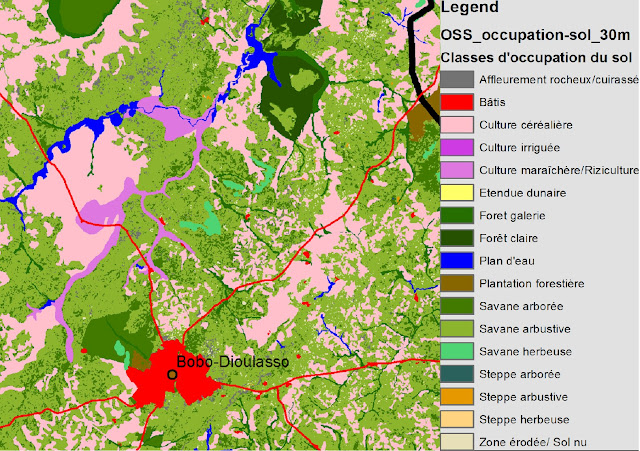I am just back from a field trip in Burkina Faso, where we went to
explore the context in one of our sites for the CLEANED project funded by the DFID SAIRLA program. This project aims at identifying trade-offs and synergies in intensifying livestock value chains.
We went to Bama, in the periphery of the second biggest city of Burkina Faso, Bobo-Dialassou.
Bama's landscape is mostly shaped by four land uses, irrigated rice production, rain-fed crop production (mainly maize, sorghum, sesame and cotton) with trees (mango, papaya, cashew nuts) and natural savanna and forest, as shown in the land cover map below.
We discovered that decision makers differentiate among three livestock keeping systems :
In
the fattening system, cows are kept for producing milk at the homestead
and fed in a cut and carry system. In the dairy system, cows are mainly
at the homestead for milking and feeding. However these cow also go
grazing in the nearby fields and grazing area. Finally, in the
traditional system, cattle is not kept for a particular purpose (meat or
milk) and goes on transhumance for part of year, i.e. goes beyond a 100
km away from their homestead.
All farmers also have sheep, that might join the transhumance or not. Also pigs are becoming more and more important.
Bama, due to its proximity to the big city has the opportunity to supply the growing demand for milk and meat. Many people choose to produce to fulfill this demand and the amount of animal that remain the whole year long is increasing, increasing the challenge for feed in the dry season and is changing the landscape.
We went to Bama, in the periphery of the second biggest city of Burkina Faso, Bobo-Dialassou.
Bama's landscape is mostly shaped by four land uses, irrigated rice production, rain-fed crop production (mainly maize, sorghum, sesame and cotton) with trees (mango, papaya, cashew nuts) and natural savanna and forest, as shown in the land cover map below.
We discovered that decision makers differentiate among three livestock keeping systems :
- fattening system
- dairy system
- traditional system
 |
| the rice paddies in Bama |
All farmers also have sheep, that might join the transhumance or not. Also pigs are becoming more and more important.
Bama, due to its proximity to the big city has the opportunity to supply the growing demand for milk and meat. Many people choose to produce to fulfill this demand and the amount of animal that remain the whole year long is increasing, increasing the challenge for feed in the dry season and is changing the landscape.
Wondering
what is driving these changes? how people see their future in the area?
of simply want to discover a new place? Then follow the SAIRLA and
Burkina Faso tag in the up-coming weeks to discover what we have learned
in Bama!




No comments:
Post a Comment